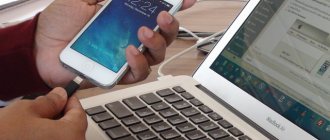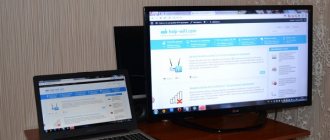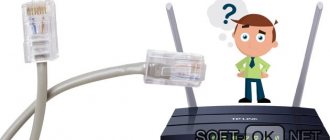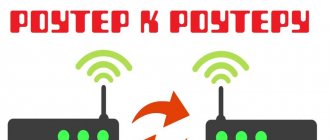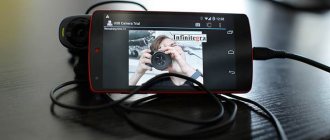If the computer does not see Android via USB, then you will not be able to download photos, videos or music, install applications not from the Play Market, or flash the device. And this is very bad, because the functionality of the phone is not fully revealed due to some stupid error.
Someone might argue that you can flash a phone without a USB connection, but for transferring files there is Wi-Fi, instant messengers, cloud storage, and finally email. But I just can’t refuse a USB connection; I constantly carry a cable with me and consider it one of the most convenient ways to transfer data.
Checking the cable and port
Before you go into your phone settings, install drivers and curse the day you bought this Android, check the cable and USB port.
I was once very surprised that the computer stopped identifying the smartphone, which it had previously seen perfectly well. It turned out that the cat liked the cable and chewed it through. From this situation I drew two conclusions: the wires must be put away in a box and inspected before connecting. The cat did not draw any conclusions. If no kinks, bites, breaks or other mechanical damage are found on the wire, check the USB port. Try connecting to a different connector or inserting another device into the same port - for example, a mouse. If Windows XP is installed on your computer, then urgently look for an opportunity to upgrade to at least “seven”. But first, you can simply install the MTP protocol so that XP learns to work with Android. The trick is that when the first version of Android appeared, Microsoft had already released Windows 7. Therefore, there is no MTP protocol in XP, and you have to install it separately. You can download MTP
If the computer detects any other device, but the phone categorically does not want to see it, then it’s time to shift the focus to Android settings and connection features. Yes, there is a possibility of mechanical damage to the microUSB connector on the phone, but I have not encountered this yet. If you have something broken, you will most likely notice it.
Most often, the inability to establish a connection between a computer and a phone is due to software errors. If none of the methods listed below help solve the problem, contact a service center - it seems that the smartphone really needs to be repaired.
Launching Android Safe Mode
You can try running Android in safe mode. In this mode, only the system works without additional programs. To start this mode, hold down the “Power” (Lock Screen) button until a window pops up where you need to simultaneously press the two buttons “Turn off” and “Restart”. After this, the “Switch to Safe Mode” window will pop up - agree and reboot the phone.
The phone will start in safe mode. Try reconnecting your smartphone to your computer. If you succeed, then there is some problem with the system or third-party applications installed on the phone. If the connection does not occur, then reboot the smartphone to get into normal mode and watch the next chapter.
Android setup
I came across two situations.
The first phone required not only obtaining developer rights and enabling USB debugging, but also installing phone drivers on the computer. In the settings of the second smartphone, I did not find any parameters responsible for connecting via USB. They are not needed: the phone is perfectly detected by the computer, after which it offers to select a connection mode. This is interesting: How to distribute mobile Internet from a smartphone via Wi-Fi? Setting up an access point (Wi-Fi router) on a phone with Android OS So, if you connected your smartphone, but nothing happened:
- Open Android Settings .
- Go to the “About phone” (may be called “About device”).
- Find the build (model) number and click on this item until a notification appears that you will soon become a developer. Usually you need to press 7-10 times .
After you become a developer, a new section will appear in Android settings - “Developer Options” . Inside it you will find a “USB Debugging” , which needs to be turned to the “On” .
Now try connecting your phone to your computer again. When connecting, a mode selection window should appear on the smartphone screen. The default setting on older versions of Android is “Charge Only”. If the window does not appear, slide it out of the notification shade.
To transfer files, you need to select media device (MTP) or storage mode. Among the options there will also be a PTP mode, but it is only suitable for photos that can just as easily be moved to MTP.
After selecting the appropriate mode in “Computer” on Windows, a media device will appear, the contents of which you can work with. Depending on your phone model and Android version, the internal memory and SD card may appear together or as separate drives. But this does not matter, the main thing is that they are displayed at all.
There are no other options in the Android settings that are responsible for connecting via USB, except for debugging. However, there are some peculiarities. For example, on Nexus smartphones, you need to unlock the screen, which is protected by a password or pattern, in order for the computer to access the contents of the memory.
Also, USB connection cannot be established if tethering mode is enabled on Android. To check its status and disable it if necessary:
- Open Settings .
- Under Network & Connections, click Advanced Settings or More .
- Enter modem mode and disable the WLAN access point . If it is disabled, you don't need to do anything else.
Some manufacturers offer users special programs to control smartphones on a computer, but you can establish a simple connection via USB without this software. Utilities from manufacturers are needed not for the banal transfer of photos, but for performing more complex tasks: updating phone software via a computer, flashing the device’s firmware, resetting settings.
The reason that the computer does not see Android via USB may be an incorrectly installed or simply crooked custom firmware. Also, sometimes a factory reset helps, but before doing it, be sure to back up your data as it will delete your data. The problem may disappear even after a normal reboot of the smartphone - keep this in mind.
Connect via Wi-Fi
Before we begin, make sure your computer and phone are connected to the same router. It doesn’t matter how the computer is connected: using a wire or via Wi-Fi - it doesn’t matter.
- Go to Google Play, install and download the “Cx Explorer” program.
- Allow access to smartphone files.
- On the “Network” tab, click on the “PC Access” button.
- Click “Start”.
- Now you will see a local address with an “FTP” port - you can use it to access your phone.
- If you type this address into the address bar, you will see all the folders on the phone, but working this way is not very convenient, so I would advise setting up a network drive for this.
- Open “Computer” and click on the map network drive button. Next, you need to click on the link “Connect to a site where...”.
- Click “Next”.
- Click “Select another network location.”
- Enter our address.
AN ERROR HAS CAME OUT! If after this an error appears, then look at the last chapter of this article.
- Check the box as in the picture below.
- We write down the name.
- We see all the folders that are on the phone.
Checking Energy Saving Settings
Windows is trying to conserve energy so that the same laptops can last longer on battery power. One of the saving factors is the automatic shutdown of USB ports. Sometimes this results in external devices not connecting at all. To check these settings and troubleshoot any deficiencies:
- Open Control Panel.
- Turn on display mode "Large Icons".
- Go to the "Power Options" .
- Find the scheme you are using and proceed to configure it.
- Choose to change advanced settings.
- Expand the USB settings and set the “On Battery” and “On Mains” to “Disabled” .
- Click "Ok" to save the configuration.
This is interesting: How to view the Wi-Fi password on an Android phone with and without root rights
I haven't measured how much the ban on automatic port shutdown affects battery life, but there is no noticeable difference. But problems with connecting external devices such as Android phones are eliminated.
Phone not connected via USB
We are trying to connect our smartphone to the computer, but it does not respond at all. Most likely there is a problem with the USB drivers of the motherboard. What are we going to do? – we will try to reinstall the drivers on them.
If you have a laptop, the process is very simple. You go to the official support and drivers page of your laptop manufacturer. After that, download and install ALL the latest drivers. I wrote about this in detail in this manual.
If you have a computer, then everything becomes a little more complicated. First we need to know the exact model of your motherboard. Open a command prompt with administrator rights through search.
We use two commands:
wmic baseboard get product wmic baseboard get Manufacturer
The first line is the model. And the second is the manufacturer. Then everything is simple - google the name of the motherboard model, go to the official website and download all the latest drivers. If possible, you can also try updating the BIOS.
Installing drivers
The first time you connect any device, Windows installs drivers for it. Often this process goes unnoticed and very quickly (as was the case with my second phone), so you may not even know that the smartphone software is on your computer. But it exists, which means it should work correctly.
- Connect your phone to your computer.
- Open Device Manager . On Windows 10, the corresponding item is in the context menu, called up by right-clicking on “Start”. In earlier versions of Windows, Manager can be found in Control Panel Icons view .
- Check all USB controllers. If there is an exclamation mark next to one of them, this indicates that there are problems with the software.
To make sure that it is the phone that is marked in the Manager, disconnect the USB cable. If the problematic controller disappears, then you have found the source of the problem. A smartphone without drivers may also appear in other sections: for example, among other or portable devices.
So, you discovered that something strange is happening with your phone drivers. What to do next?
- Connect your phone so it appears in Device Manager.
- Select it and delete it.
- Update the hardware configuration so that the computer detects the phone again and begins installing drivers.
You don't have to remove the device, just update the driver. Right-click on the phone, select the “Driver” and click “Update” . Another option is to first remove the driver and then install it again without touching the device itself.
In the search box, select automatic detection. If you downloaded the phone driver from the official website, you can click “Search on this computer” and specify the path to the downloaded software file.
If you have a Chinese smartphone, then there may be another problem with it - the inability to find a suitable driver on the Internet. They are often posted on forums like 4PDA, but if there is nothing, try installing a universal driver. It's called Universal Adb Driver and is designed to ensure the Android Debug Bridge and PC syncing utilities work properly with Android devices. Universality is not always good, but there is a high probability that in the case of a Chinese phone you will be able to simply access the contents of the memory.
Connection via Bluetooth
If you only need to transfer files, you can use Bluetooth. The Bluetooth connection is wireless, and file transfer is fast and easy.
First, make sure Bluetooth is turned on on both Android and computer. If everything is turned on, your PC will appear on your phone in the list of devices with which you can connect. Once you select this device, the connection code will be displayed on your PC and phone. Enter it and click the Pair button to establish the connection.
When the connection is established, right-click on the Bluetooth icon in the system tray. Then select either “Send File” or “Receive File” and select the desired file. After clicking the “Next” button, the file transfer will begin.
Troubleshooting error code 19
If, when you connect your phone, the computer displays a message about the inability to start the device due to incomplete or damaged settings, then you need to check the system registry. But be careful: deleting the wrong entries can cause Windows to stop working.
- Press Win+R .
- Execute "regedit".
- Expand HKEY_LOCAL_MACHINE/SYSTEM/CurrentControlSet/Control/Class/{EEC5AD98-8080-425F-922A-DABF3DE3F69A}.
- Find the UpperFilters , highlight it and delete it.
This is interesting: The best dialers for Android - a replacement for a standard phone
After removing the setting, restart your computer and try connecting your phone again.
Alternative file transfer methods
If you are unable to resolve the USB connection problem and need to transfer files right away, use one of the alternative methods.
- Sync your data via Google Drive. Android requires a Google account to function properly, so you definitely have access to cloud storage. You can transfer files through other services – DropBox, OneDrive. I use Yandex.Disk.
- Transfer files via email, instant messengers or social networks. I often add small files to Documents on VKontakte, and then download them to my computer.
- Install the AirDroid application on your phone and access the memory through a browser on your computer.
You can come up with other options for connecting an Android smartphone to a computer. For example, create an FTP server on your phone or set up a remote connection via TeamViewer. So USB is not the only option. But if a wired connection is not established, it is still worth looking at what the reason is and, if possible, eliminating it.
Programs for synchronizing your smartphone and computer via USB
You can connect a smartphone to a computer using third-party software not only in the case of a PC based on the Linux or macOS operating system. A similar operation can also be performed in conjunction with a Windows PC. Currently, there are a huge number of pairing programs. We suggest using one of the following utilities:
- MyPhoneExplorer;
- Microsoft Windows Mobile Device Center;
- SyncDroid.
Also, don’t forget about the AirDroid application, which is also available on computers with the Windows operating system. Regardless of which software is ultimately selected, the connection will occur according to the following scenario:
- Install the application on both devices.
- We connect the phone to the PC using a USB cable.
- We launch the installed program and make sure that the smartphone is identified correctly.
If the operation is performed correctly, you will not have any difficulties with data exchange. If problems arise at one of the connection stages, do not be lazy to read the instructions posted on the website of the developers of a particular program.
